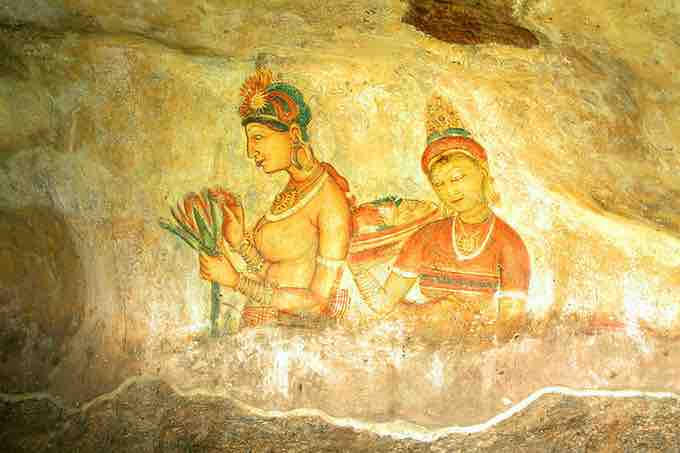Painting from 300-500 CE
Very little Southeast Asian painting from 300 - 600 CE has survived to the present day, owing to the heat and humidity of tropical and subtropical weather. One can only hypothesize the styles and techniques that painters would have used based on evidence gleaned from sculpture (which is far more durable and has survived), contemporary painting styles in India (which played a large role in influencing Southeast Asian art), and literary texts that talk about painting. The few examples of painting that do survive are frescoes on cave or temple walls.
Approaches
Artists worked in perishable mediums, painting mostly on wood, cloth, and palm leaf, none of which have withstood the rigors of the Southeast Asian climate. The most durable forms of Southeast Asian art are sculpture and architecture in stone. It is likely that stone sculptures, both in relief and in the round, were originally painted in bright colors, but these have worn away over the course of time, leaving the underlying stone exposed. Frescoes, usually executed on cave temple or monastery walls, would have been the most common form of Southeast Asian painting.
Themes
The themes most commonly depicted would probably mimic those found in contemporary Southeast Asian sculpture—primarily religious themes from Hindu and Buddhist mythology. Hinduism and Buddhism, both of which originated in the Indian subcontinent, were introduced to Southeast Asia from the 1st century BCE to the 1st century CE. Southeast Asia subsequently came under the influence of several powerful Indic dynasties, which established kingdoms, practiced and spread Hinduism and Buddhism through the region, and patronized art that reflected their religious beliefs.
Hindu art commonly depicted figures from the Hindu pantheon, including the gods Shiva and Vishnu and the divine female creative principle or Shakti. Buddhist art depicted images of the Buddha, the Bodhisattvas or enlightened beings, apsaras or celestial dancers, and tales and parables from Buddhist lore, including the Jataka tales—stories about the previous incarnations of the Buddha, both in human and in animal form. It is also possible that Southeast Asian painting would have depicted court and battle scenes, animals both real and mythical, and scenes from daily life. In Thai art, the most frequent narrative subjects for paintings included the Jataka stories, episodes from the life of the Buddha, the Buddhist heavens and hells, and scenes of daily life. Some of the scenes are influenced by Thai folklore instead of following strict Buddhist iconography.
Frescoes in Sigiriya
The most famous surviving examples of Southeast Asian-style frescoes are to be found in the rock fortress and palace ruin of Sigiriya in Sri Lanka. These date from about the 5th-6th centuries CE and depict graceful female figures bearing flowers. These figures are hypothesized to be apsaras, or women of the king's court. The paint has been applied in sweeping strokes, using more pressure on one side than the other and resulting in deep colors toward the edge. These frescoes are reminiscent of the contemporary frescoes in the Ajanta Caves in India, which are masterpieces of Buddhist religious art and depict figures from the Buddhist pantheon and scenes from the Jataka tales.

Sigiriya Fresco
The frescoes at Sigiriya depict graceful female figures bearing flowers.